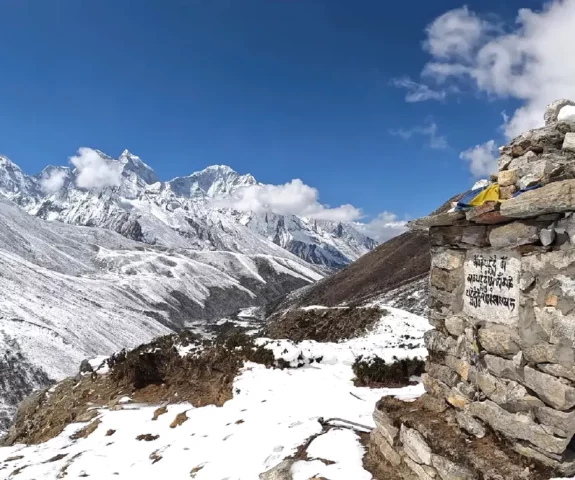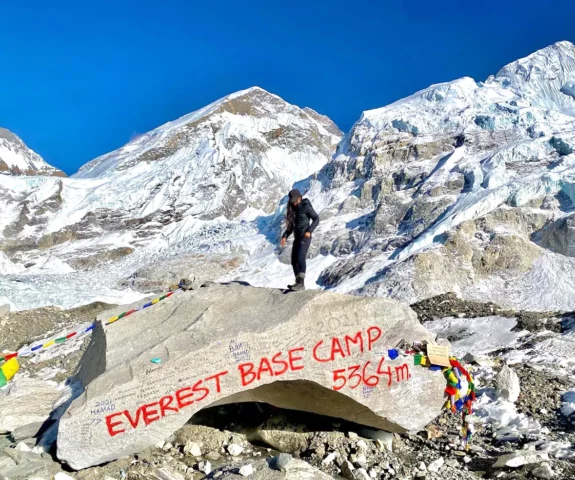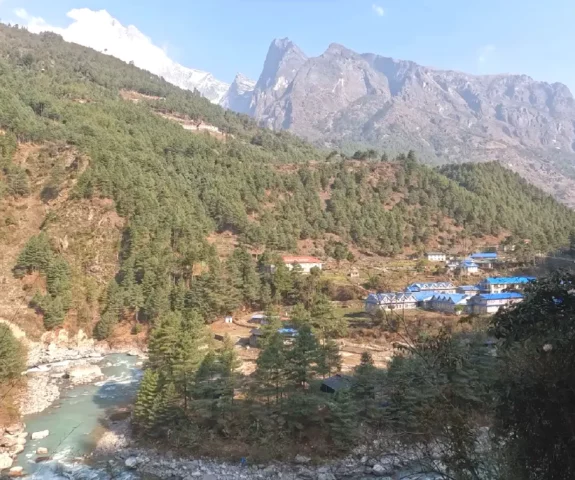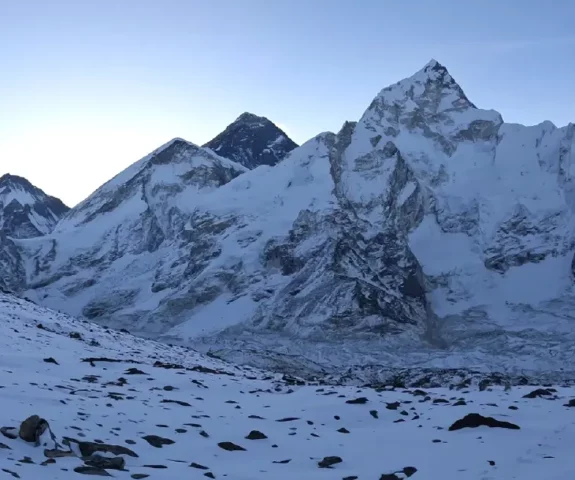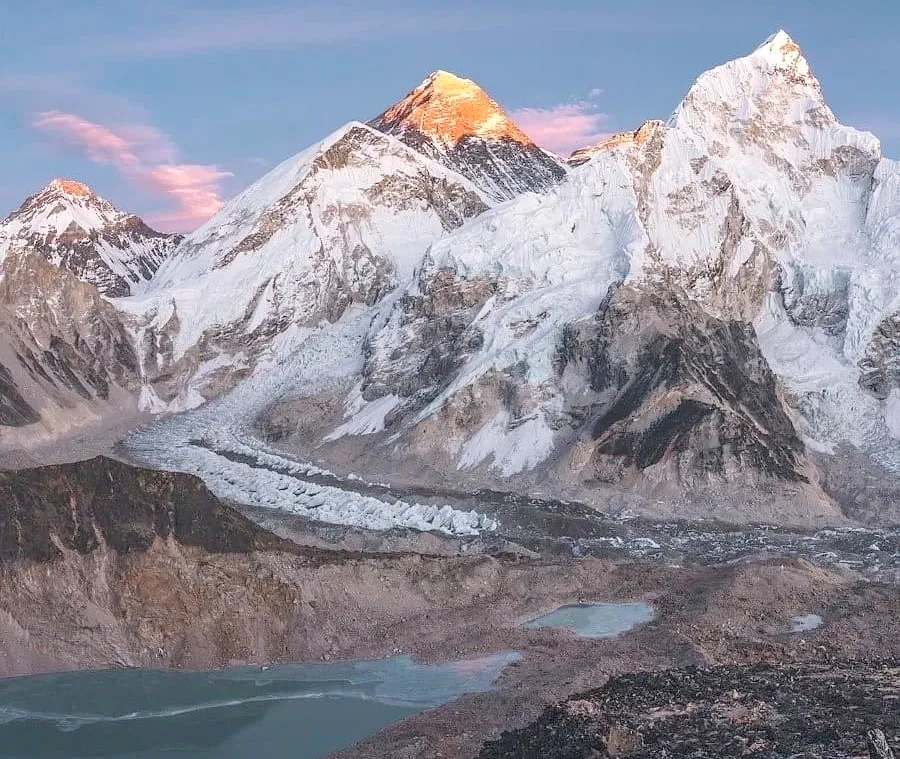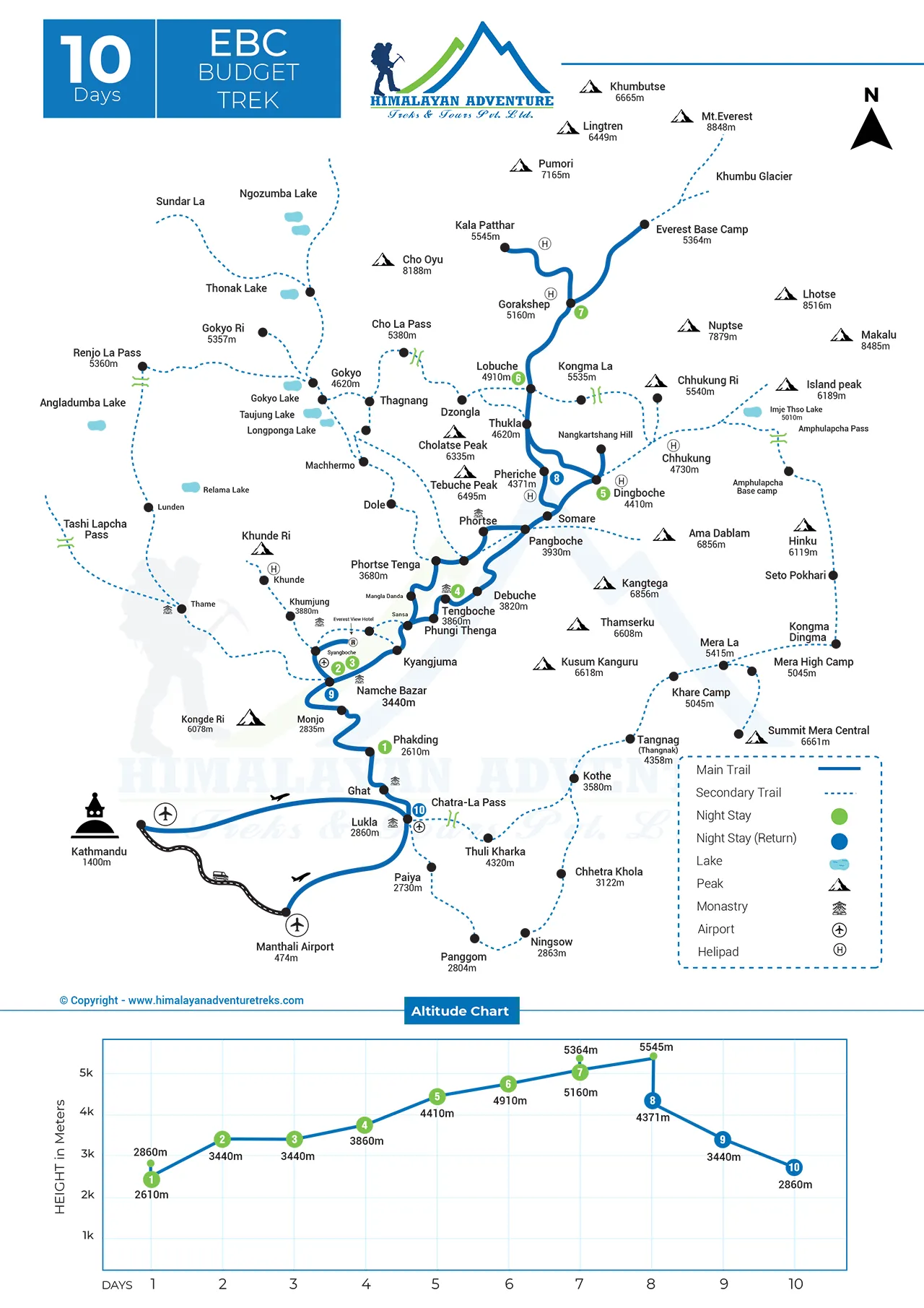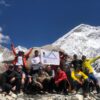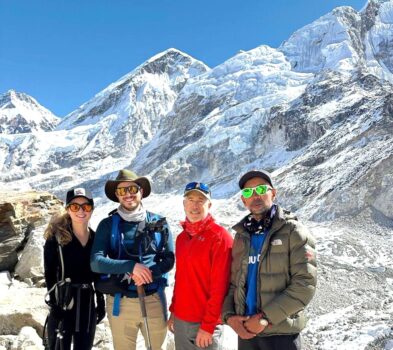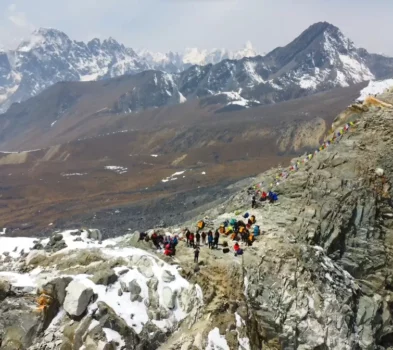Duration
10 DaysEverest Base Camp Budget Trek
Trip Grade
ModerateGroup Size
1-16 PeopleMax Altitude
5,545m. / 18,192ft.Best Season
Feb- May/ Sept- NovActivity
Trekkling & HikingAccommodation
TeahousesTrip Customization
On request (click here)Highlights of Everest Base Camp Budget Trek
- Scenic Views: Stunning vistas of snow-capped peaks including Mount Everest, Lhotse, Nuptse, and Ama Dablam.
- Cultural Immersion: Interaction with Sherpa communities, visits to monasteries such as Tengboche, and experiencing local traditions and hospitality.
- Challenging Terrain: Trekking through diverse landscapes including lush forests, alpine meadows, glacial moraines, and rocky terrain.
- High-Altitude Passes: Crossing high-altitude passes like the Kongma La, Cho La, and Renjo La, offering panoramic views and thrilling challenges.
- Everest Base Camp: Reaching the iconic Everest Base Camp, a symbolic achievement and opportunity for photos with the world’s highest peak.
- Kalapatthar: Summiting Kalapatthar for unparalleled views of Everest at sunrise, providing one of the trek’s most unforgettable moments.
- Sherpa Villages: Exploring picturesque Sherpa villages like Namche Bazaar, Dingboche, and Gorak Shep, rich in culture and history.
- Flora and Fauna: Encounters with unique Himalayan flora and fauna, including rhododendrons, blue sheep, and various bird species.
- Buddhist Monuments: Visiting ancient Buddhist stupas, prayer flags, and monasteries, immersing in the spiritual ambiance of the Himalayas.
- Tea Houses: Staying in cozy tea houses along the trail, enjoying warm hospitality, and bonding with fellow trekkers over hearty meals and beverages.
- Challenging Weather: Coping with the unpredictable Himalayan weather, including cold temperatures, strong winds, and occasional snowfall.
- Personal Growth: Overcoming physical and mental challenges, pushing personal limits, and gaining a sense of accomplishment and resilience.
Trip Introduction
Mt. Everest (8848.86m) and the Khumbu Valley are known to house some of the most famous trekking trails in Nepal. As such, the Everest Base Camp Trek is the most iconic of them all. The trek explores the natural and cultural riches of the Everest region and concludes at the Everest Base Camp. As such, the Everest Base Camp Budget Trek is a shorter version of this grand adventure. Thus, this trip visits the beautiful destinations which have attracted thousands of travelers across the world. All in all, this trip is best for those who want to trek in the Everest region in a limited time frame.
Like any other trip in Nepal, your adventure begins in Kathmandu. Next, you head to the Everest region on a short flight to Lukla. Here, you land at the Tenzing Hilary Airport and begin the trek. You will trek across the Dudh Koshi River and reach Phakding on your first night on the trek. Then, you enter the Sagarmatha National Park as you relish its biodiversity on the way to Namche. At Namche Bazaar, you can explore the village and experience modern amenities in the company of the Himalayas. Further, you continue along the Imja River to reach Tengboche. From here, you continue to ascend to Dingboche.
Then, the trails enter the snowy region as you continue to Thukla. Crossing the Thukla Pass, you head to Lobuche. Further, you trek along the Khumbu Glacier to reach Gorak Shep. Finally, you make the trek to Everest Base Camp Budget Trekking while enjoying the views of Mt. Everest (8848.86m), Pumo Ri (7165m), and Nuptse (7861m). At the Base Camp, you can also relish the sights of Khumbu Glacier and Icefall. After you return to Gorak Shep, you hike to KalaPatthar. It is one of the most famous vantage points to soak in the views of Everest Himalayas. For the final part of the trek, you descend through Sherpa villages and reach Lukla. A scenic flight from Lukla brings you back to Kathmandu.
Everest Base Camp Budget Trek is a grand and difficult trip in the Himalayas. So, it is necessary for the trekkers to be in good physical condition. Similarly, the autumn and spring seasons are the best times to do the trek.
At Himalayan Adventure Treks, we always offer the best finest services to our clients. Also, we provide numerous trip packages and offers in Nepal.
Reason to do Everest Base Camp Budget Trek:
- Iconic Destination: Everest Base Camp is the starting point for mountaineers attempting to summit the world’s highest peak, Mount Everest. Trekking to this legendary location allows you to stand in the shadow of Everest and witness its awe-inspiring presence.
- Breathtaking Scenery: The trek offers unparalleled views of some of the world’s highest and most majestic peaks, including Everest, Lhotse, Nuptse, and Ama Dablam, as well as stunning landscapes of glaciers, valleys, and alpine forests.
- Cultural Experience: Trekking through the Khumbu region provides an opportunity to immerse yourself in Sherpa culture and traditions. You’ll visit traditional villages, monasteries, and stupas, interact with local people, and gain insights into their way of life.
- Physical Challenge: The Everest Base Camp Trek is physically demanding, involving long days of hiking at high altitudes. For many trekkers, the challenge of conquering steep ascents, navigating rugged terrain, and overcoming altitude-related obstacles is a significant draw.
- Sense of Achievement: Reaching Everest Base Camp is a monumental achievement for many trekkers, representing a personal triumph over physical and mental challenges. Standing at the base of the world’s highest peak is a symbol of determination, resilience, and perseverance.
- Adventure and Exploration: Trekking to Everest Base Camp is an adventure of a lifetime, offering the thrill of exploring remote and pristine wilderness, encountering diverse flora and fauna, and experiencing the raw beauty of the Himalayas up close.
- Spiritual Connection: The Himalayas have long been revered as sacred mountains in various cultures and religions, including Buddhism and Hinduism. Trekking through this ancient landscape can evoke a profound sense of awe, spirituality, and connection to the natural world.
- Personal Growth: The Everest Base Camp Budget Trek is not just a physical journey but also a journey of self-discovery and personal growth. It challenges you to push beyond your comfort zone, confront your fears and limitations, and emerge stronger, more resilient, and more confident.
Best season for Everest Base Camp Budget Trek:
The best season for trekking to Everest Base Camp (EBC) is generally considered to be during the pre-monsoon (spring) and post-monsoon (autumn/fall) seasons. Here’s a breakdown of these seasons and why they are preferred:
Spring (Pre-Monsoon):
Months: March to May
- Weather: Spring offers stable weather conditions with clear skies, mild temperatures, and minimal rainfall. The days are generally sunny and warm, making it ideal for trekking.
- Scenery: The spring season brings vibrant colors to the landscape with blooming rhododendrons and other wildflowers, enhancing the beauty of the trekking route.
- Visibility: Clear skies provide excellent visibility of the surrounding mountains, including Mount Everest and other Himalayan peaks.
- Crowds: Although spring is a popular trekking season, it is less crowded compared to the autumn season, allowing for a more peaceful and enjoyable experience.
- Autumn/Fall (Post-Monsoon):
- Months: September to November
- Weather: Autumn is characterized by stable weather conditions, with clear skies, mild temperatures, and low humidity. Rainfall is minimal, and the air is crisp and refreshing.
- Scenery: The autumn season offers stunning views of the Himalayan landscape, with clear visibility and vibrant colors as the foliage changes to shades of gold, red, and orange.
- Trails: The trekking trails are in excellent condition during autumn, making it easier to navigate and providing a more comfortable trekking experience.
- Festivals: Autumn coincides with major festivals in Nepal, such as Dashain and Tihar, allowing trekkers to experience local culture and celebrations in villages along the route.
- Crowds: Autumn is the peak trekking season in Nepal, attracting a large number of trekkers from around the world. While this means more crowds on the trail and in tea houses, it also creates a lively atmosphere and opportunities to meet fellow trekkers.
Both spring and autumn offer favorable weather conditions, stunning scenery, and memorable trekking experiences. The choice between these seasons ultimately depends on personal preferences regarding weather, crowd levels, and cultural events. Regardless of the season chosen, it’s essential to check weather forecasts and trail conditions before embarking on the trek.
Everest Base Camp Budget Trek and its difficult:
The Everest Base Camp (EBC) Budget Trek presents several challenges and difficulty that trekkers should be aware of and adequately prepared for. Here are some of the key difficulty associated with the EBC Trek:
- High Altitude: One of the most significant challenges of the EBC Trek is the high altitude. The trek reaches elevations above 5,000 meters (16,400 feet), where oxygen levels are lower, and altitude-related illnesses such as acute mountain sickness (AMS), high altitude pulmonary edema (HAPE), and high altitude cerebral edema (HACE) can occur. Acclimatization is crucial to minimize the risk of altitude sickness.
- Physical Demands: The EBC Budget Trek involves long days of hiking, often on steep and uneven terrain. Trekkers should be prepared for challenging ascents and descents, including sections of rocky trails, narrow paths, and high mountain passes. Physical fitness and endurance are essential to tackle the demanding trekking routes.
- Weather Conditions: Weather in the Himalayas can be unpredictable and harsh, especially at higher altitudes. Trekkers may encounter cold temperatures, strong winds, snowfall, and sudden changes in weather conditions. It’s essential to be prepared with appropriate clothing and gear to stay warm and dry.
- Tea House Accommodations: Accommodations along the EBC Budget Trek are basic tea houses or lodges, offering limited amenities and facilities. Trekkers should be prepared for simple accommodations, shared bathrooms, and occasional cold showers. Tea houses can also get crowded during peak trekking seasons, requiring early booking.
- Altitude-Related Symptoms: Altitude sickness can affect trekkers at various stages of the EBC Trek, especially as they ascend to higher altitudes. Symptoms of altitude sickness may include headaches, nausea, fatigue, dizziness, and difficulty sleeping. Trekkers should be familiar with the signs and symptoms of altitude sickness and take appropriate measures if they experience any symptoms.
- Remote and Isolated Terrain: The EBC Trek takes place in remote and isolated areas of the Himalayas, far from medical facilities and emergency services. Trekkers should be prepared for self-sufficiency and carry essential items such as a first aid kit, water purification tablets, and communication devices in case of emergencies.
- Trekking Duration: The EBC Trek typically takes around 12 to 16 days to complete, depending on the itinerary and pace. Trekkers should be prepared for long days of hiking and be able to sustain their energy levels throughout the duration of the trek.
Despite these challenges, the EBC Trek is a highly rewarding and unforgettable experience for many trekkers, offering stunning mountain scenery, cultural immersion, and a sense of accomplishment upon reaching Everest Base Camp. Proper preparation, including physical conditioning, acclimatization, and packing appropriate gear, can help mitigate the difficulties associated with the trek. Additionally, hiring an experienced guide and following their advice can enhance safety and enjoyment during the journey.
How we prepare physically and mentally for Everest Base Camp Budget Trek?
Preparing physically and mentally for the Everest Base Camp Budget (EBC) Trek is essential to ensure a safe, enjoyable, and successful journey. Here are some key steps to prepare for the physical and mental challenges of the trek:
Physical Preparation:
- Cardiovascular Fitness: Focus on improving cardiovascular endurance through activities such as hiking, walking, running, cycling, or swimming. Aim to gradually increase the duration and intensity of your workouts to build stamina for long days of hiking.
- Strength Training: Incorporate strength training exercises to build muscular strength and endurance, especially in the legs, core, and upper body. Include exercises such as squats, lunges, deadlifts, push-ups, and pull-ups to strengthen the muscles needed for hiking and carrying a backpack.
- Hiking Practice: If possible, engage in regular hiking practice on trails with varied terrain and elevation gains. This will help simulate the conditions of the Everest Base Camp Budget Trek and prepare your body for the demands of trekking at high altitudes.
- Interval Training: Incorporate interval training workouts to improve your cardiovascular fitness and endurance. Interval training involves alternating between periods of high-intensity exercise and rest, helping to improve aerobic capacity and recovery.
- Flexibility and Mobility: Perform regular stretching and mobility exercises to improve flexibility, reduce the risk of injury, and enhance recovery. Focus on stretching the major muscle groups used during hiking, such as the calves, hamstrings, quadriceps, and hip flexors.
- Altitude Training (if possible): If possible, consider altitude training or simulated altitude training to acclimatize your body to the lower oxygen levels experienced at higher altitudes. This can include training in hypoxic chambers or using altitude simulation devices.
Mental Preparation:
- Set Realistic Expectations: Understand the challenges and difficulties associated with the EBC Trek and set realistic expectations for yourself. Recognize that trekking to high altitudes involves physical exertion, discomfort, and potential adversity, but also offers incredible rewards and experiences.
- Develop a Positive Mindset: Cultivate a positive attitude and mindset towards the trek, focusing on the opportunities for growth, adventure, and personal achievement. Visualize yourself successfully completing the trek and overcoming any obstacles that may arise along the way.
- Practice Mindfulness and Resilience: Practice mindfulness techniques such as meditation, deep breathing, and visualization to reduce stress, increase focus, and enhance mental resilience. Learn to stay present in the moment and adapt to changing conditions with a calm and composed mindset.
- Educate Yourself: Educate yourself about the trekking route, weather conditions, altitude sickness, and other potential challenges you may encounter during the EBC Trek. Knowledge and preparation will help alleviate anxiety and build confidence in your abilities.
- Seek Support: Surround yourself with a supportive network of family, friends, and fellow trekkers who can provide encouragement, advice, and assistance throughout your journey. Share your goals and concerns with others, and seek guidance from experienced trekkers or guides if needed.
- Stay Flexible and Adapt: Understand that plans may change, and unforeseen circumstances may arise during the trek. Practice flexibility and adaptability, and be prepared to adjust your itinerary, pace, or expectations as necessary to ensure your safety and well-being.
By following these physical and mental preparation strategies, you can enhance your readiness for the Everest Base Camp Trek and increase your chances of having a successful and fulfilling trekking experience. Remember to listen to your body, pace yourself appropriately, and prioritize safety at all times during the trek.
Everest Base Camp Budget Trek Cost:
No of People Price P.P
1 – 1 USD 600
2 – 2 USD 400
3 – 5 USD 350
6 – 10 USD 325
11 – 16 USD 300
Outline Itinerary of Everest Base Camp Budget Trek
Day 01: Trek from Lukla to Phakding.
Day 02: Trek from Phakding to Namche Bazaar.
Day 03: Acclimatization Day Visit Khumjung Village, Hotel Everest View (3880m).
Day 04: Trek from Namche Bazaar to Tengboche (3860m).
Day 05: Trek from Tengboche to Dingboche (4360m).
Day 06: Trek from Dingboche to Lobuche (4910m).
Day 07: Trek from Lobuche to EBC (5360m) to Gorakshep (5160m).
Day 08: Trek from Gorakshep to Kalapatthar (5545m) to Pheriche (4371m).
Day 09: Trek from Pheriche to Namche Bazaar (3446m).
Day 10: Trek from Namche Bazaar to Lukla (2860m).
Our guests sharing their experiences (Photo/Video Gallery)
Detail itinerary of Everest Base Camp Budget Trek
Day 01: Trek from Lukla to Phakding.
The trek from Lukla (2,860m) to Phakding (2,610m) is a relatively short and scenic journey, covering approximately 5.6 miles (9 km) in 3-4 hours. The trail begins with a gradual descent from Lukla, passing through picturesque villages like Chheplung and Ghat, surrounded by lush greenery and traditional Buddhist prayer wheels and mani stones. The Dudh Kosi River flows alongside the path, with several suspension bridges adding to the adventure. Trekkers can enjoy stunning views of Kusum Kanguru (6,369m) and other Himalayan peaks in the distance. The trail is well-defined and relatively easy, making it a great warm-up for the upcoming trek to higher altitudes. Upon reaching Phakding, a small riverside village, trekkers can relax in cozy teahouses, explore nearby monasteries, or take a short acclimatization walk before continuing toward Namche Bazaar the next day.
Activity: Trek, 3-4 hours
Max. Altitude: 2,610m/8,563ft. Phakding
Accommodation: Teahouse
Day 02: Trek from Phakding to Namche Bazaar.
The trek from Phakding (2,610m) to Namche Bazaar (3,446m) covers approximately 7.5 miles (12 km) and takes around 6-7 hours. The trail follows the Dudh Kosi River, crossing several suspension bridges, including the famous Hillary Suspension Bridge, surrounded by lush forests of pine and rhododendron. Along the way, trekkers pass through charming Sherpa villages like Monjo and enter Sagarmatha National Park, where permits are checked. The trek involves a gradual ascent before a steep climb of nearly 600 meters leading to Namche, offering the first glimpse of Mount Everest on a clear day. As the gateway to Everest, Namche Bazaar is a bustling Sherpa town with shops, cafes, and stunning mountain views, making it an essential acclimatization stop. Trekkers can explore local markets, visit the Sherpa Museum, or rest in cozy teahouses to prepare for higher altitudes.
Activity: Trek, 6-7 hours
Max. Altitude: 3,446m/11,306ft. Namche Bazaar
Accommodation: Teahouse
Day 03: Acclimatization Day Visit Khumjung Village, Hotel Everest View (3880m).
An acclimatization day in Namche Bazaar (3,446m) is essential for adjusting to higher altitudes before continuing the trek. A popular and rewarding side trip is a visit to Khumjung Village (3,790m) and the famous Hotel Everest View (3,880m). The hike begins with a steep ascent to Syangboche Airstrip (3,780m), offering breathtaking panoramic views of Mount Everest (8,848m), Lhotse, Ama Dablam, and Thamserku.
From Syangboche, a short uphill walk leads to Hotel Everest View, one of the highest luxury hotels in the world, where trekkers can enjoy a refreshing tea or coffee while admiring the stunning Himalayan scenery. The trail then descends to Khumjung Village, a traditional Sherpa settlement known for its Khumjung Monastery, which houses a purported Yeti scalp. Trekkers can also visit the Edmund Hillary School, built by Sir Edmund Hillary’s Himalayan Trust to support local education. After exploring the village and interacting with the friendly Sherpa community, the return journey follows a scenic route back to Namche Bazaar, completing a well-balanced day of acclimatization and cultural exploration.
Activity: Hike, 4-5 hours
Max. Altitude: 3,880m/12,730ft. Khumjung Village
Accommodation: Teahouse
Day 04: Trek from Namche Bazaar to Tengboche (3860m).
The trek from Namche Bazaar (3,446m) to Tengboche (3,860m) covers approximately 6 miles (9.7 km) and takes around 5-6 hours. The trail begins with a gradual ascent, offering breathtaking views of Everest, Lhotse, Nuptse, Ama Dablam, and Thamserku. After passing through Kyangjuma, the trail descends through pine and rhododendron forests to the Dudh Kosi River, crossing the bridge at Phunki Tenga (3,250m).
After Phunki Tenga, a steep uphill climb of about 600m leads to Tengboche, home to the famous Tengboche Monastery, the largest Buddhist monastery in the Everest region. This spiritual site offers a serene atmosphere, with monks chanting prayers against the backdrop of Ama Dablam (6,812m). Trekkers can explore the monastery, witness the evening prayers, and enjoy the peaceful surroundings before settling into nearby teahouses for the night.
Activity: Trek, 5-6 hours
Max. Altitude: 3,860m/12,664ft. Tengboche
Accommodation: Teahouse
Day 05: Trek from Tengboche to Dingboche (4360m).
The trek from Tengboche (3,860m) to Dingboche (4,360m) covers approximately 6 miles (9.8 km) and takes around 5-6 hours. The trail begins with a descent through lush rhododendron and pine forests to Deboche (3,820m), a small settlement with a quiet Buddhist nunnery. From here, the path crosses the Imja Khola River via a suspension bridge, leading to Pangboche (3,985m), the highest permanent Sherpa village in the region.
As the trek continues, the landscape becomes more barren, with fewer trees and more alpine terrain. Passing Somare (4,010m) and Orsho, trekkers get stunning views of Ama Dablam, Lhotse, and Island Peak. The final stretch involves a gradual ascent along the Imja Valley, leading to Dingboche, a beautiful village surrounded by stone-walled fields that protect crops from strong winds. With its breathtaking mountain views, Dingboche serves as a crucial acclimatization stop before heading to higher altitudes.
Activity: Trek, 5-6 hours
Max. Altitude: 4,360m/14,304ft. Dingboche
Accommodation: Teahouse
Day 06: Trek from Dingboche to Lobuche (4910m).
The trek from Dingboche (4,360m) to Lobuche (4,910m) covers approximately 5 miles (8 km) and takes around 5-6 hours. The trail starts with a gradual ascent towards Dughla (Thukla) (4,620m), passing through barren landscapes with breathtaking views of Ama Dablam, Lhotse, and Cholatse. As the altitude increases, vegetation becomes sparse, and the terrain turns more rugged.
After reaching Thukla, a steep climb leads to the Thukla Pass (4,830m), where trekkers pass a touching memorial site with stone chortens dedicated to climbers who lost their lives on Everest. From here, the trail levels out, offering mesmerizing views of Pumori, Nuptse, and the Khumbu Glacier. A final gentle ascent brings trekkers to Lobuche, a small yet essential stop before continuing toward Everest Base Camp. Due to the high altitude, trekkers are advised to walk slowly, stay hydrated, and rest well to acclimatize properly.
Activity: Trek, 5-6 hours
Max. Altitude: 4,910m/16,109ft. Lobuche
Accommodation: Teahouse
Day 07: Trek from Lobuche to EBC (5360m) to Gorakshep (5160m).
The trek from Lobuche (4,910m) to Everest Base Camp (5,360m) and then to Gorakshep (5,160m) is a challenging yet rewarding journey covering approximately 7.5 miles (12 km) in 7-8 hours. The trail follows the rocky and glacial moraine path along the Khumbu Glacier, offering stunning views of Pumori, Nuptse, and Everest’s western shoulder. The high altitude makes the trek physically demanding, so a slow and steady pace is crucial.
After about 2-3 hours, trekkers reach Gorakshep, the last settlement before Everest Base Camp. Leaving backpacks at the teahouse, they continue towards Everest Base Camp (5364m), navigating rough terrain and glacial ridges for another 1.5-2 hours. Upon arrival, trekkers are greeted by the iconic prayer flags, ice formations, and the towering presence of Mount Everest (8,848m). The base camp provides a breathtaking close-up view of the Khumbu Icefall, but Everest’s peak remains hidden from this spot.
After celebrating the achievement and taking memorable photos, trekkers return to Gorakshep, following the same route. The evening is spent resting and preparing for an early morning climb to Kala Patthar (5,545m) for the best sunrise view of Everest.
Activity: Trek, 7-8 hours
Max. Altitude: 5,365m/17,602ft. Everest Base Camp
Accommodation: Teahouse
Day 08: Trek from Gorakshep to Kalapatthar (5545m) to Pheriche (4371m).
The trek from Gorakshep (5,160m) to Kala Patthar (5,545m) and then down to Pheriche (4,371m) covers approximately 10 miles (16 km) and takes around 7-9 hours. The day begins with an early morning ascent to Kala Patthar, a steep and challenging 1.5-2 hour climb. The reward at the summit is a breathtaking panoramic sunrise view of Mount Everest (8,848m), Lhotse, Nuptse, Pumori, and Ama Dablam. This is the best vantage point for viewing Everest in its full glory, making it a highlight of the trek.
After spending some time at Kala Patthar, trekkers descend back to Gorakshep for breakfast before starting the long descent to Pheriche. The route retraces steps past Lobuche (4,910m) and Thukla Pass (4,830m), where trekkers pass the memorial chortens dedicated to fallen climbers. The trail then follows a gentle downhill path along the Khumbu Glacier moraine, offering stunning views of the valley and surrounding peaks. Upon reaching Pheriche, a lower-altitude village, trekkers can enjoy a more comfortable climate, better oxygen levels, and cozy teahouses for a well-earned rest.
Activity: Trek, 7-8 hours
Max. Altitude: 5,545m/18,192ft. Kalapatthar
Accommodation: Teahouse
Day 09: Trek from Pheriche to Namche Bazaar (3446m).
The trek from Pheriche (4,371m) to Namche Bazaar (3,446m) covers approximately 14 miles (22 km) and takes around 6-7 hours. The trail starts with a gradual descent through the Imja Valley, passing through Pangboche (3,985m), the highest permanent Sherpa village in the Everest region. Trekkers can visit the famous Pangboche Monastery, one of the oldest in the Khumbu region, before continuing towards Deboche (3,820m) and Tengboche (3,860m).
After a short break in Tengboche, known for its beautiful Tengboche Monastery, the trail descends steeply to Phunki Tenga (3,250m), crossing the Dudh Kosi River via a suspension bridge. The next stretch is a steady uphill climb through rhododendron and pine forests leading to Kyangjuma, offering breathtaking views of Ama Dablam, Everest, and Lhotse. The final leg involves a gentle walk back to Namche Bazaar, where trekkers can enjoy a warm meal, a hot shower, and explore the lively Sherpa town before the final descent back to Lukla.
Activity: Trek, 6-7 hours
Max. Altitude: 3,446m/11,306ft. Namche Bazaar
Accommodation: Teahouse
Day 10: Trek from Namche Bazaar to Lukla (2860m).
The trek from Namche Bazaar (3,446m) to Lukla (2,860m) covers approximately 13.5 miles (22 km) and takes around 6-7 hours. The trail begins with a steep downhill descent toward the Dudh Kosi River, passing through Larja Dobhan and crossing the high Hillary Suspension Bridge. Trekkers then continue through Jorsalle (2,740m) and Monjo (2,835m), where they exit Sagarmatha National Park.
The route follows a mix of gentle ups and downs through beautiful forests, passing Benkar, Phakding (2,610m), and Ghat, with stunning views of the surrounding valleys and mountains. After Phakding, the final stretch includes a gradual uphill walk before reaching Lukla, where trekkers celebrate the completion of their Everest adventure. In Lukla, they can relax, explore the town, and enjoy a warm meal before their flight back to Kathmandu the next morning.
Activity: Trek, 5-6 hours
Max. Altitude: 2,860m/9,383ft. Lukla
Accommodation: Teahouse
Note:
If you have your own private group and want to make your trip private, we can run the custom trip all the day as per your requirements and group size.
Includes and Excludes
What are included with package?
- National Park Permit: The necessary National Park permit for your trek is included in the package.
- TIMS Permit: The Trekkers’ Information Management System (TIMS) permit, which is required for trekking in Nepal, is included.
- Necessary Paperwork: All required paperwork, including permits and documentation for the trek, will be handled for you.
- Accommodation During Trek: All accommodations in teahouses and lodges during the trek are arranged and included.
- Experienced Guide: An experienced, helpful, and friendly guide will accompany you throughout the trek, ensuring your safety and comfort.
- Travel and Rescue Arrangements: Assistance with travel safety and rescue arrangements will be available if needed during the trek.
- Medical Supplies: A first aid kit will be available with the guide to handle any medical emergencies that may arise during the trek.
What are not included with package?
- Nepal Visa Fee: The Nepal visa fee is not included, but it can be easily obtained upon arrival at Kathmandu Airport.
- International Airfare: International flights to and from Kathmandu are not included in the package.
- Domestic Transport: Domestic airport pick-up and drop-off by a private vehicle are not included in the package.
- Domestic Flight to Lukla: The cost of the domestic flight to Lukla and return to Kathmandu is not included in the package.
- Porter: Porters for your trekking needs are not included; if you wish to hire one, it will be at an additional cost.
- Mountain Expenses Beyond Schedule: Any additional expenses incurred in the mountains due to unexpected delays, such as bad weather, flight cancellations, or early returns, are not covered and are the responsibility of the traveler.
- Travel and Rescue Insurance: Travelers are required to have their own travel and rescue insurance, which is not included in the package.
- Personal Expenses: Costs for personal items such as phone calls, laundry, bar bills, battery charging, extra porters, bottled or boiled water, and hot showers are not covered by the package.
Pick Your Suitable Date
Book a Private Trip
Private & Group Discount Price
-
1 -
1 person
US$ 600
-
2 -
2 people
US$ 400
-
3 -
5 people
US$ 350
-
6 -
10 people
US$ 325
-
11 + people
9999
US$ 300
Total Cost:
US$ 600
Route Map & Altitude Chart
Lukla
Start/End point
Lukla
Trip Information
Physical Fitness:
Many people have questions as to what level of physical fitness is required for trekking in Nepal and that is extremely reliant on what activity the visitor is engaging in Nepal With that said, for a standard easy trek to Extreme hard level of trekking. The daily activity (trek) would be 5-6 hours,(depend on the trekking trail) and elevation will generally not exceed 5,600 meters like Everest Base Camp, Throng la passes, Chola passes treks and other passes or Base Camp but some of them are less than 4000m. The trekking day is involving both long steep climbs, and descents with a variety of terrain underfoot from well-trodden paths, to rocks covered with ice or snow, depending on the season. Mostly a day would include a number of climbs or descents of 600 meters more or less, starting after the early morning breakfast, resting at a lunch place in the afternoon, then continuous trekking until arriving at the teahouse.
In preparation for trekking in Nepal, it is important, to begin with, the basic training requirement at least 2 months before departing for trekking in Nepal. Two to three hours of aerobic exercise like running, walking, swimming, cycling & some gym work per week is the minimum and most will find it beneficial to add some basic strength training to their physical fitness routine required for the hard trekking and for normal and easy trek just have some physical fitness is enough. One of the best ways to prepare is to take practice hikes with a daypack roughly the same weight as what you will be taking during the trek. Your calf should be enough fit and prepare for trekking. Mostly during the trekking calf pain or tiredness is the main issue. Do this only after a baseline of fitness has been reached. Moving fast is not our goal, will provide a more enjoyable and safe adventure trekking in Nepal for all easy and hard level.
Trekking Seasons in Nepal:
There are main two seasons in which Nepal where the most amount of visitors visit. (September, October & November) being the most popular season which is also called the peak season in Nepal, and spring (March, April & May) coming in close behind which is also called the mini-season in Nepal. The summer months of June, July, and August are the monsoon season and most of the time raining as such the trails are mostly washed out sometimes, and roads can sometimes be impassible due to landslide activates. Nevertheless, you can trek to rain-shadow regions like Upper Dolpo and Upper Mustang during the monsoon seasons. Nepal is a suitable destination for all seasons.
Winter is very dry & extremely cold and all the high passes become inaccessible due to ice and snow conditions. The temperature doesn’t usually fluctuate during the day time temperature is around 20-25 degrees. However, you gain altitude the temperature decreases. The temperature can drop to around 0 to -25 degrees at night when staying at tented camps in the Himalayan regions. Winter trek in higher altitudes is not advised due to the danger of avalanches and also altitude sickness. Although some may enjoy the sight of the snow-covered mountains as you reach your destination. However, the temperature does not change as much in lower mountain regions the nights are slightly colder than days’ time.
Autumn &Spring is the best timing for trekking in Nepal because the weather is generally warm and dry, and flowers are in bloom in the lower elevations of the country on the same time you can see the many festivals during that period.
Trekking Day:
A typical trekking day begins with the early morning breakfast around 7 am in the hotel. (Depend on the trekking region). It would advise you to pack your trekking gears in a duffle bag and essential supplies in your day pack after having breakfast; we begin the trek and head along the trail at around 8 am. The morning walk is more energetic to be longer as we begin with refreshed bodies and enthusiasm. A good morning’s walk, we make a stop for lunch at around 11-12 pm. The lunch involves group meals enjoying the vicinity around the stop & enjoys the organic & local food in the mountain. After resting for about an hour or two, we resume our trek to reach the teahouses or camp by 2-3 pm. The afternoon walk is relatively shorter and can involve games and side trips as organized by the trekking experienced guides. You also can enjoy breaks during the trek to relax, read, and stroll around the area or doing yoga. You can explore with the local people and observe their lifestyle & culture. Dinner is served around 7-8 in the evening to round off the day.
Meals and Accommodations:
During the trekking period, the accommodation is commonly referred to as teahouses. These are family-run basic lodges that fill the role of the restaurant, Dining hall, and boarding house for tourists. Now a day’s electricity can be found in the rooms, which means one light bulb, and one or two outlets for charging electronics. The common areas are also lit by electricity. Alternatively, teahouses may also use solar, hydroelectric, or have electrical lines running into the village, so the commonality and availability of electricity may vary. Still, a few of the trekking route electricity service is not available. Use the local traditional kerosene light.
Most of the teahouses have private rooms, though if the trek is in a more remote or high altitude place there are limited teahouses so season time dormitories are the norm. Most of the room has 2 single beds with basic bedding, and the bathroom is shared. Some of the places we can get the private bathroom also with a mix of western and squat style toilets in the bathrooms.
Breakfast and dinner are taken at the same teahouses and these lodges have large family-style dining rooms centered on a stove or coal to provide heat basically in mountain areas. Most of the area’s menu will have Nepali-style western foods such as Pancake, pizza, Burger, fries, etc. Also on the menu is the traditional Nepali food Dal Bhat meal. This is a lentil soup with rice, vegetable, Pickle, or meat curry. Most menus will also offer a smattering of local cuisine.
Internal Flight Delays:
Nepal is an incredible and beautiful country mixed with the White Mountains, deep valleys, Landscape, rivers, and green rolling hills. With this incredible diversity of landscapes, road travel can be extremely time-consuming and flights within Nepal to reach popular trekking destinations is the easiest way. Not all the trekking destination has flight service, so road transportation is the only option. Mountainous terrain also comes with the possibility of in-climate weather. It mentions the incredibly high number of visitors during peak seasons makes internal flight delays a genuine possibility. To manage this situation, it may be helpful to have a few extras days on either end of your tour. If any cancellations or flight delays do occur (high chances of flight delays from around Kathmandu to Lukla, Everest region, Pokhara to Jomsom, Annapurna region), we also provide services to arrange chopper on the last stage to help you to be on your schedule on the premises of Civil Aviation Rules in Nepal which state that helicopters can fly if the visibility is 1500m. The cost ranges from USD400 to USD650 according to the number of passengers. The payment can be made either to the helicopter company or to us directly and can be made either by cash or using a credit card. It will be beneficial to purchase and review your insurance, the insurance companies may cover some of the alternative measures of travel. Flight insurance may cover changing your international flight if it is necessary.
Travel Insurance:
Most expeditions, Adventurous trekking, and tours require that travel insurance and it is purchased prior to arriving in Nepal, but other normal treks and tours may not require it. However, travel insurance is definitely an important consideration. There are a number of reasons to consider insurance. Firstly, it may be required, so check to see what is being asked for by the company. Second, Nepal is a landlocked country, and there are only a few direct flights. Travel in and out of the country can encounter some disruptions if purchasing insurance, make sure flight delays and cancellations also included. Always choose insurance that, though every safeguard is in place during your Holiday, there are always extenuating circumstances that may result in an accident during trekking & tours. Read carefully printout of insurance policies to ensure that the trekking or any other activity you are engaging in is covered or not, as some policies have stopped covering trekking in certain places. If you are going above 5000 m or high always mention the policies so it’s cover the chopper service in the last condition. It is very important that if you have the comfort of good insurance, so do the research and choose carefully which makes your trip relaxing and joyful.
Nepal Visa Entry Procedure:
There is only one International airport which is the Tribhuvan International Airport in Nepal. Immigration Office, TIA (Tribhuvan International Airport) under the Department of Immigration has been facilitating tourists flying to Nepal by providing visas on Arrival.
The ‘On Arrival’ visa procedure is very quick and simple. October, November, March, April can expect some queues during peak Tourist season and October is basically the Nepalese got the Main festival Dashain. You can also get Visa from Nepalese Diplomatic Missions stationed abroad prior to your arrival. The choice is yours.
Visa obtains from Nepalese Diplomatic Missions, and then you must enter Nepal within six months from the visa issued date. Your total stay is counted starting from the day you enter Nepal.
Visas obtained on Arrival at the Entry and Exit points are ‘Tourist Visas’. They bear multiple Re entry facilities. Tourist Visa ‘On Arrival’ is the only entry visa to Nepal. If you are visiting Nepal for purposes other than Tourism (sightseeing, tour, travel, mountaineering, trekking, visiting friends and families), you should still get a ‘Tourist Visa’ to get into the country. However, you must change the category of visa as per your purpose and length of stay in Nepal from the Department of Immigration by producing the required documents.
Please click below for the online Visa form.
http://online.nepalimmigration.gov.np/tourist-visa
The following visa rules apply for tourists:
For 15 days Multiple Entry Visa, the visa fee US $ 30 or equivalent foreign currency.
For 30 days Multiple Entry Visa, the visa fee US $ 40 or equivalent foreign currency.
For 100 days Multiple Entry Visa, the visa fee US $ 100 or equivalent foreign currency.
According to the immigration regulations, a tourist is allowed to stay in Nepal only for 150 days a year. You can extend the visa up to another 90 days.
US$ 2 or equivalent Nepalese currency per day for extension.
Additional US$ 25 or equivalent Nepalese currency on visa fee, if Multiple Entry facility is required for the extended period
For more details please visit our FAQ link
https://www.himalayanadventuretreks.com/faq/
Acute Mountain Sickness (AMS):
Acute Mountain Sickness (AMS) is usually seen in un-acclimatized people shortly after ascent to high altitudes. The condition occurs due to the thinning of air as the altitude increases. The condition, if not taken seriously and treated immediately, can be life-threatening and its symptoms can be seen generally above 3200 meters. The symptoms of Acute Mountain Sickness are nausea, vomiting, tiredness, shortness of breath, and cerebral pain. The itineraries are designed to properly acclimatize you to the change in high altitude climate and sufficient precautionary measures too are taken to take utmost caution for our valuable guests. Our staff also equipped with cell phones and satellite phones (Option) in the occurrence of any emergency cases. We are greatly driven to keep the safety and security of our clients as our foremost concern.
Drinking-Water:
Water is essential for life, and clean water is imperative while on holiday. When visiting less developed countries like Nepal it is a concern that all travelers should consider. There are few options when trekking or traveling in Nepal that will mitigate any chances of drinking contaminated water. The first consideration to take into account is that tap water should not be ingested. That even means when brushing your teeth in an urban area. Most will choose to buy bottled water and if doing so make sure the cap has sealed properly. Plastic bottle reuse is a big problem, and with that being said there are other options on the market to assist in making water drinkable. Mountain spring water is drinkable but if you use the purified tablet. The conservation area project also sells this tablet to most of the trekking area. A guide will assist you to find out it also.
Arrival Instruction:
Upon your arrival at Tribhuvan International Airport (TIA) Kathmandu Nepal, our company representatives are stationed to welcome you to the country. We request you to carefully look for your and company name placard being held by our representatives following the events upon landing. Our representatives will be responsible to escort you up to your hotel in Kathmandu. There are many brokers, Taxi drivers, and troublemaker people offering you to carry your luggage and take you to your destination as you exit from the gate. We request you to pay no attention to these people and follow the company representatives and follow their instructions.
How to Book Your Tour:
Before booking any tour or trekking please read all the terms and conditions thoroughly and call or email the company representative with any questions prior to making any payments. Begin by filling out a booking form and pay the non-refundable deposit. Fill out the form completely and if any confusion contacts the company person so as not to disrupt the expediency of the process. The form may be submitted online or by downloading the form and mailing or Whatsapp the form to your company representative.
It is very important to understand all aspects of the chosen trip, from what’s included and excluded, to the level of service, or even what trip may be right for your level of experience and fitness. Take the time to get all the questions answered so that when booking the trip, it is without trepidation.
Equipment List for Everest Base Camp Budget Trek:
Everest Base Camp Budget Trek is not easy trekking but however our long-year experience of operating Trekking to Nepal, We learn many things and would like to give some information to pack your equipment list for your Everest Base Camp Budget Trek and we hope, this information will be helpful you so success your trip.
Luggage/Duffle bag:
You will require a duffel bag or a backpack for trekking (65- 75 L) max and all our trekking stuff is kept in this duffle bag and this will be carried by our porters. However, Himalayan Adventure also provides the duffle back if needed.
A day backpack:
You will need a day backpack and you will be carrying it every day by yourself and we recommend you it has to be at least 25L and you can carry important documents like Passport, credit card along with a need to carry a water bottle, snacks bar and clothing layers (hat, gloves, fleece, sunblock, poles, etc…).
Trekking/Hiking boots:
Everest Base Camp Budget Trek is not easy to trek and It is very important to have good trekking boots and it should be waterproof (in case of snow, or rain) Make sure it should be fit on your feet and comfortable during walking. Also, recommend you bring the Crompton during the winter season in Nepal.
Sport sandals:
You need to have a pair of sports shoes or sandals to use while you are in camp or tea houses after the trek.
Sneakers:
Everest Base Camp Budget Trek is difficult trekking so sneakers are not suitable for this trek so you can leave your sneakers in the Kathmandu hotel until you get back.
Sleeping Bag:
You need to have a lightweight sleeping bag that works for minus 15 degrees for the summer season but during the winter we recommend minus 20 degrees for the Everest Base camp budget trek. Himalayan Adventure can provide it if you need one but has to be returned after the trek.
Fleece jacket:
You need to have good quality fleece jacket at least 1 synthetic jacket or pullovers are a great alternative to fleece because they are lighter and more compressible and gives you enough warmth during trekking.
Down jacket:
A down jacket is compulsory and recommends you bring warm enough so can keep you warm during the Everest Base Camp Budget Trek.
Socks:
You need to have at least 5 pairs of thick socks during the spring & autumn but winter and monsoon need at least 7 pairs of socks for the Everest Base Camp Budget Trek.
Lightweight/ warm insulated pants:
You need to have at least 3 pairs of lightweight trekking pants like Lightweight expedition thermal bottoms, Nylon hiking shorts, Softshell and hardshell trekking pants, Water/windproof trousers, and Casual pants so we can use them like the weather.
Short-sleeved shirts:
You need to have 3 ice-breaker merino wool to keep you warm from the cold or synthetic shirts and if you are not allergic to wool products, merino wool is the ideal for Everest Base Camp Budget Trek.
Long-sleeved shirts:
You need to have at least three shirts.
Underwear:
You need to have few pairs of underwear and this can be as much as you need as there are no washing facilities every day on Everest Base Camp Budget Trek so, we highly recommend you to have enough pair of underwear.
Waterproof jacket:
You need at least one waterproof jacket for the rain/snow and wind for the Everest Base Camp Budget Trek and waterproof pants may be an option.
Head and face gear:
Sun Hat or cap during the daytime, Woolen Hat for morning & Evening, and Polarized sunglasses are compulsory.
Hand gear:
You need warm gloves.
Traveling supplies:
Adapter Plug for Charging the Camera and Mobile, Camera belt, Passport belt ( nice to have), Swiss army knife (option), Flashlight, Headlamp, Water bottle, Extra camera battery, Hand sanitizer, Alarm clock, Hiking poles (optional ), and Binoculars (optional).
Toiletries:
Razor, razor blades, shaving cream, aftershave toothbrush, toothpaste, dental floss, sunscreen, toilet paper, small towel, and period pads (for women).
Medication:
First Aid Medical Kit box (can be purchased in Thamel Kathmandu), Altitude Medicines (Diamox), Tylenol, aspirin, ibuprofen, Anti-diarrheic, Powerful antibiotics, and Nasal Spray or Drops.
Essential Packing Gear List for Everest Base Camp Budget Trek
If you have decided to go on Everest Base Camp Budget Trek in High Himalayas of Nepal, we assure you, that you will have a fantastic time ahead. But what should you pack? What will be the right gear to make your trip more fabulous? To help you with this, we have compiled a packing list of essential items that you mustn’t forget to bring along.
- Passport ( min 6 months valid)
- Cash, credit card
- List of important addresses and contact details
- 2-3 passport photos (Optional)
- Copies of all important travel documents (passport, visa, airline ticket, insurance policy, etc.)
- A sturdy 70 L trekking backpack which will be carried by your porter (please note that our assigned 1 porter will carry 2 client’s luggage up to 20-25 kg.
Note: we will provide each participant with a spacious 70 to 75 L Company logo duffle bag to conveniently carry your trekking gear which you have to return once the trek is complete. - A 30 L Daypack that has room for your essentials such as camera, mobile, Passport, important documents, water bottle, day use medicine, chocolate bars, raincoat, etc. which will be carried by you.
- Protective cover for backpack or travel bag.
- Hiking Boots: Preferable ankle-high boots to prevent ankle sprain
- Regular Shoes: For small strolls and exploration around the city
- Second, a light pair of shoes and possibly sandals
- Micro Spikes or Ice Cleats for the winter trekking over snow and ice
- Gaiter for the added protection in snow
- Rain and wind-resistant lightweight down jacket for warmth with a good helmet hood
- Summery-light, as well as winter warm clothing
- Quick-drying shirts made of synthetic fabrics
- Warm and cool vest or T shirts
- Functional synthetic underwear
- Sports Bra for Female Trekker
- A waterproof trouser
- Regular trousers of quick-drying fabric
- Hiking shorts
- Cargo Pants with multiple pockets to hold your small items such as knives or chocolates
- Woolen or fleece pants
- Trekking socks both thick or woolen fabric and lighter wool sock
- Wool hat, gloves, and scarf
- A light cotton scarf or a bandanna for protection of your head, neck, ears, and mouth
- Sun hat, and sunglasses with 100% UV protection (for trekking trips even with stray light and nose protection)
- Sunscreen cream or lotion with a high sun protection factor (at least 15, for trekking trips even at least 30)
- Sunscreen lipstick with a high SPF (at least 20, for trekking trips even at least 30 or sunblock)
- Mosquito repellent (Optional)
- Comfortable light night clothes and shoes
- Drinking bottle that can be used as a hot water bottle on frosty nights
- Flip-flops or bathing shoes for using the showers
- Water purifiers: if you need to refill water from the tap or stream en route
- Headlamp: for midnight or pre-dawn trip towards the viewpoint
- Quick-drying towel and sample-size toiletries for washing your feet and face
- Your personal first-aid kit: with basic medical supplies such as bandage for sprain, antidiarrheal and antibiotics, iodine wipes for scrapes and cuts, plasters, aspirin, or ibuprofen, moleskin for preventing blisters, Diamox (acclimatizing medicine), and your personal medication
- Sleeping bag appropriate for all seasons treks (we can hire at Kathmandu)
- Waterproof money belt, chest bag, leg bag, or belt bag for storing important travel documents or valuables
- Toothpaste, Toothbrush, and soap
- Deodorants
- Moisturizer
- Nail clippers
- Feminine hygiene products (Sanitary Pads)
- Small mirror
- Wet wipes
- Hand sanitizer
- Comb
- Camera with sufficient memory cards and spare batteries or battery charger
- Small padlock for your travel bag
- Crampons ( during winter, Dec- Feb)
- Thermos flask
- Water bag
- Toilet paper (2-3 rolls without)
- Ear Plugs
- Match Box, or lighter
- Compass or GPS
- Map
- Alarm clock
- Multi-tool kit
- Binoculars
- Books
- Whistle
Equipment Note:
- Please note that there is no need for you to bring all these heavy items such as Sleeping bag, Down Jacket, Trekking Poles, items from your home. You can easily rent or purchase high to standard quality items in Kathmandu, Pokhara, and Namche Bazaar as well.
- Items are available from international brand such as North Face, Sherpa Adventure, Marmot, Mountain Hardware, Black Yak, Karma Gear and local brands like Goldstar and local made products etc.
- Plus, we will also gift you a company logo T-shirt as a token of your experience in Nepal with us.
Renting Cost:
- Sleeping Bag & Down Jacket (-10-20 degree Celsius), Per Piece per day US$ 1.5
Frequently Asked Questions
What is the Everest Base Camp Budget Trek?
The Everest Base Camp Budget Trek is a cost-effective version of the classic Everest trek that takes you through the Khumbu Valley to the base of Mt. Everest (8848.86m). It is ideal for trekkers who want to experience the Everest region within a limited time and budget, while still enjoying the natural beauty and Sherpa culture.
Where does the Everest Base Camp Budget Trek begin and end?
The trek begins with a short and scenic Lukla flight from Kathmandu to Tenzing Hillary Airport, and it ends with a return flight from Lukla back to Kathmandu. The trek route covers iconic locations like Phakding, Namche Bazaar, Tengboche, Lobuche, Gorak Shep, and Everest Base Camp.
What are the major highlights of the Everest Base Camp Budget Trek?
Key highlights include walking through Sagarmatha National Park, witnessing the towering Himalayan peaks such as Pumo Ri, Nuptse, and Mt. Everest, visiting Everest Base Camp, and hiking up to Kala Patthar, the best viewpoint for panoramic views of Everest and the Khumbu Glacier.
How difficult is the Everest Base Camp Budget Trek?
This is considered a moderate to strenuous trek due to high altitudes and long trekking days. Trekkers should be in good physical condition and ideally do some preparation beforehand. The trek involves walking 5–7 hours per day, often in cold and changing weather conditions.
How do you prepare for Mount Everest Base Camp Trek?
The Everest Base Camp Budget Trek typically takes 10 to 12 days, depending on the specific itinerary and acclimatization needs. This duration includes the Lukla flight, trekking days, rest days in Namche Bazaar, and the return journey.
What kind of accommodations are available on the budget trek?
Trekkers stay in budget teahouses or lodges along the route. These offer basic facilities such as shared rooms, common dining areas, and traditional Nepali meals like dal bhat. While simple, they provide warmth, hospitality, and a chance to interact with the local Sherpa communities.
Do I need a permit for the Everest Base Camp Budget Trek?
Yes, two main permits are required: the Sagarmatha National Park Permit and the Khumbu Pasang Lhamu Rural Municipality Permit. These permits are essential for entering and trekking through protected areas in the Everest region.
When is the best time to do the Everest Base Camp Budget Trek?
The best seasons are spring (March to May) and autumn (September to November). These periods offer clear mountain views, stable weather, and vibrant natural scenery. These months are perfect for exploring the Khumbu Valley and enjoying views from Kala Patthar.
Is altitude sickness a concern during the trek?
Yes, altitude sickness is a serious risk on the Everest Base Camp Trek, especially above 3,000 meters. It’s important to follow proper acclimatization routines, stay hydrated, and avoid rushing. Spending rest days in places like Namche Bazaar helps with adaptation.
What makes the Everest Base Camp Budget Trek different from luxury treks?
The budget trek focuses on minimizing costs by using basic teahouse accommodation, group transport, and fewer luxury add-ons. However, it still offers the same incredible journey to Everest Base Camp, views of Mt. Everest, and the cultural richness of the Sherpa lifestyle, making it ideal for trekkers on a budget.




